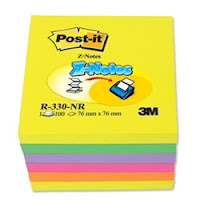I love a Post It. I’ll admit it. I also get to do the stationery order (oh the joys!) so I order the boring yellow ones but also all the hearts, thumbs up, cars and smiley faces. These are hoarded in my draw and whipped out at any opportunity. Now, give a Y10 boy a Post It and he is immediately going to draw something rude on it and stick it to his head. I don’t know why, but it is a fact. Once you have dealt with this and have clear expectations then the humble Post It can be one of your best learning tools.
In my room this is actually the whiteboard. During my lessons pupils are given a Post It to promote a learning dialogue between themselves and me. They are encouraged to write a note about something they learnt or are having difficulty with, encouraging pupil voice. This is stuck on the board and collected in at the end of the lesson; I stick the pile into my planner and have a look later that evening. The Post Its guides my next lesson, I may have a selection of comments that say ‘You are going to fast!’, ‘I am not sure about poetic devices’ or, the very touching ‘I need more help in lessons, I may look clever but I am not’. These notes then change the next lesson’s context and mean I can focus on what the class really needs. Equally, if I get lots of Post Its that say ‘I understand the use of foreshadowing now’ I know I can move on. Pupils may write their names on the Post Its or leave them anonymous, this allows less out going pupils to be heard. If you have especially shy pupils it is worth going around and collecting the Post Its yourself rather than displaying them.
You can also use the Post It Wall for questioning, for example ‘Tell me 2 things I can do to make your lessons better’, ‘What have you found the hardest today?’ ‘What would you like to learn more about next lesson?’
These simple sticky notes have really made a difference to my lessons. I know my pupils feel that their voice is heard and that they help contribute to their lessons, this also makes a difference to their behaviour and the atmosphere in the room becomes one of a team environment rather than ‘them and me’.



